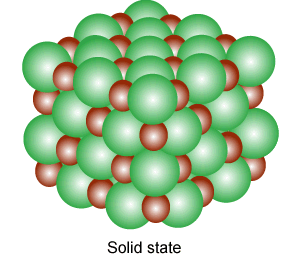Question:
An element (atomic mass $100 \,g /\, mol$ ) having $BCC$ structure has unit cell edge $400\, pm$. The density of element is (No. of atom in $BCC ( Z )=2$ ).
An element (atomic mass $100 \,g /\, mol$ ) having $BCC$ structure has unit cell edge $400\, pm$. The density of element is (No. of atom in $BCC ( Z )=2$ ).
Updated On: Apr 28, 2024
- $10.376\, g/cm^3$
- $5.1888 \,g/cm^3$
- $7.289\, g/cm^3$
- $2.144 \,g/cm^3$
Hide Solution
Verified By Collegedunia
The Correct Option is B
Solution and Explanation
No. of atoms per unit cell in $b.c.c.$ lattice $(n) = 2$
Density, $d = \frac{n \times M}{a^3 \times N_A}$
$ = \frac{2\times 100}{(4\times 10^{-8}\,cm)^3 \times 6.02 \times 10^{23}}$
$ = \frac{200}{38.528} $
$ = 5.19\,g/cm^3$.
Density, $d = \frac{n \times M}{a^3 \times N_A}$
$ = \frac{2\times 100}{(4\times 10^{-8}\,cm)^3 \times 6.02 \times 10^{23}}$
$ = \frac{200}{38.528} $
$ = 5.19\,g/cm^3$.
Was this answer helpful?
0
0
Top Questions on The solid state
- A metal crystallizes in simple cubic lattice. The volume of one unit cell is \( 6.4 \times 10^{-7} \, \text{pm}^3 \). What is the radius of the metal atom in pm?
- AP EAPCET - 2025
- Chemistry
- The solid state
- A metal crystallises in two cubic phases, fcc and bcc with edge lengths 3.5 Å and 3 Å respectively. The ratio of densities of fcc and bcc is approximately
- TS EAMCET - 2025
- Chemistry
- The solid state
- How many kinds of Bravais lattice are possible in a crystal?
- Bihar Board XII - 2025
- Chemistry
- The solid state
- The percentage of free space in a body-centred cubic unit cell is
- Bihar Board XII - 2025
- Chemistry
- The solid state
- Which of the following is not a crystalline solid?
- Bihar Board XII - 2025
- Chemistry
- The solid state
View More Questions
Questions Asked in NEET exam
- With the help of the given pedigree, find out the probability for the birth of a child having no disease and being a carrier (has the disease mutation in one allele of the gene) in the F3 generation.

- NEET (UG) - 2025
- Genetics
- The plates of a parallel plate capacitor are separated by d. Two slabs of different dielectric constant \(K_1\) and \(K_2\) with thickness \(d/2\) and \(d/2\) respectively are inserted in the capacitor. Due to this, the capacitance becomes two times larger than when there is nothing between the plates. If \(K_1 = 1.25 K_2\), the value of \(K_2\) is :
- NEET (UG) - 2025
- Capacitors and Capacitance
- The correct order of the wavelength of light absorbed by the following complexes is:
A. $[ \text{Co(NH}_3\text{)}_6]^{3+}$
B. $[ \text{Co(CN)}_6]^{3-}$
C. $[ \text{Cu(H}_2\text{O)}_4]^{2+}$
D. $[ \text{Ti(H}_2\text{O)}_6]^{3+}$
Choose the correct answer from the options given below:- NEET (UG) - 2025
- Coordination chemistry
- Consider the diameter of a spherical object being measured with the help of a Vernier Callipers. Suppose its 10 Vernier Scale Divisions (V.S.D.) are equal to its 9 Main Scale Divisions (M.S.D.). The least count in the M.S. is 0.1 cm and the zero of V.S. is at -0.1 cm when the jaws of Vernier callipers are closed. If the main scale reading for the diameter is \(M = 5\) cm and the number of coinciding vernier division is 8, the measured diameter after zero error correction, is:
- NEET (UG) - 2025
- Measurement of length
- In some appropriate units, time (t) and position (x) relation of a moving particle is given by \(t = \alpha x^2 + \beta x\). The acceleration of the particle is :
- NEET (UG) - 2025
- Kinematic equations for uniformly accelerated motion
View More Questions
Concepts Used:
Solid State
Solids are substances that are featured by a definite shape, volume, and high density. In the solid-state, the composed particles are arranged in several manners. Solid-state, in simple terms, means "no moving parts." Thus solid-state electronic devices are the ones inclusive of solid components that don’t change their position. Solid is a state of matter where the composed particles are arranged close to each other. The composed particles can be either atoms, molecules, or ions.

Types of Solids:
Based on the nature of the order that is present in the arrangement of their constituent particles solids can be divided into two types;
- Amorphous solids behave the same as super cool liquids due to the arrangement of constituent particles in short-range order. They are isotropic and have a broad melting point (range is about greater than 5°C).
- Crystalline solids have a fixed shape and the constituent particles are arranged in a long-range order.